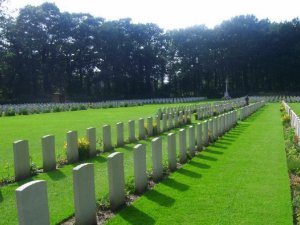
Oosterbeek War Cemetery
The end of Operation Market Garden left the allies in possession of a 60 male salient into Holland. While a large part of Dutch territory had been liberated, the corridor led to nowhere, the aims of Market Garden had not been achieved.
For the Allied soldiers left fighting in Holland, the coming winter would be cold and miserable. The US Airborne Divisions were only withdrawn into reserve in time to take part in the Battle of the Bulge in the Ardennes. Meanwhile to the west the British and Canadians were involved in a bitter struggle to clear the approaches to Antwerp, a priority that had been overlooked in the dash to outflank the Rhine.
The Dutch civilians left in Arnhem and Oosterbeek were cleared from their houses after the battle. They suffered a terrible winter, during which much of the Dutch population starved, being left to eat tulip bulbs. They paid a terrible price for an operation that Monty described as ‘90% succesful’.
The wounded and captured faced months of hardship and anguish until they were liberated at the end of the war. Many of the wounded were taken to a Hospital in Apeldoorn, and then on to POW Camps in Germany. Many were held at Stalag XIB near Fallingbostel, on the North German Plain. One of them was my Granddad, who was later moved to Stalag IIIA near Berlin before being liberated by the Russians.
Strategically, the British Second Army had been driven northwards by its advance. This in turn led to the US First Army moving northwards to stay in touch with it, opening up a dangerous gap with Patton’s US Third Army further South. In typical Patton fashion his Army had been advancing eastwards of his own accord. This gap was exploited by the Germans in December 1944.
Could Monty’s plan have worked? If Eisenhower had backed it fully with resources, and halted Patton, it is likely that the plan would have had more success, despite the failures at Arnhem. Whether the Allies could have carried on into Germany is difficult to assess. The Battle at Arnhem would have been very different had the Dropping Zones been selected closer to the Bridge, if the whole Division had been landed in two drops on one day, if Browning had stayed at home and if XXX Corps had driven with more haste at critical moments. Concerns about flak were unfounded, and Browning played little part in the battle.
Market Garden has often been cited as a blot on Monty’s reputation. It would be hard to argue that it was indeed a daring plan, and very nearly worked. But as much as it is true to say that the allies needed to capture all of the Bridges or the operation was not worth it, it is also accurate to state that unless the operation was made a complete priority and given the appropriate resources, it was not worth the risk. While Eisenhower did not want to upset American public opinion, winning the war quickly should have been more important.
Arnhem was eventually liberated in April 1945, by the 49th (West Riding) Division. The town has been rebuilt, and every year in September Veterans and grateful Dutch people gather to commemorate the Battle, which has passed into legend as one of the bravest yet most spectacular failures in military history. Nevertheless, Heroic stories abound. The story of Flight Lieutenant David Lord VC, who kept piloting his burning Dakota so his crew could escape. Major Robert Cain VC, who repeatedly fought off German tanks. Of Lance Sergeant Baskeyfield VC, who manned an anti-tank gun on his own, destroying tank after tank until killed. But most of all, the ordinary men who fought at Arnhem, and maybe didnt win medals, but did their best. We should be very proud of them.
1,514 men are buried in Arnhem-Oosterbeek War Cemetery. Nearby the Hartenstein Hotel Airborne Museum tells the story of the battle, and has just undergone a multi-million refurbishment. All of the sights and places of the battle are still there to look at, from the Drop Zone at Ginkel Heath to Arnhem Bridge.







